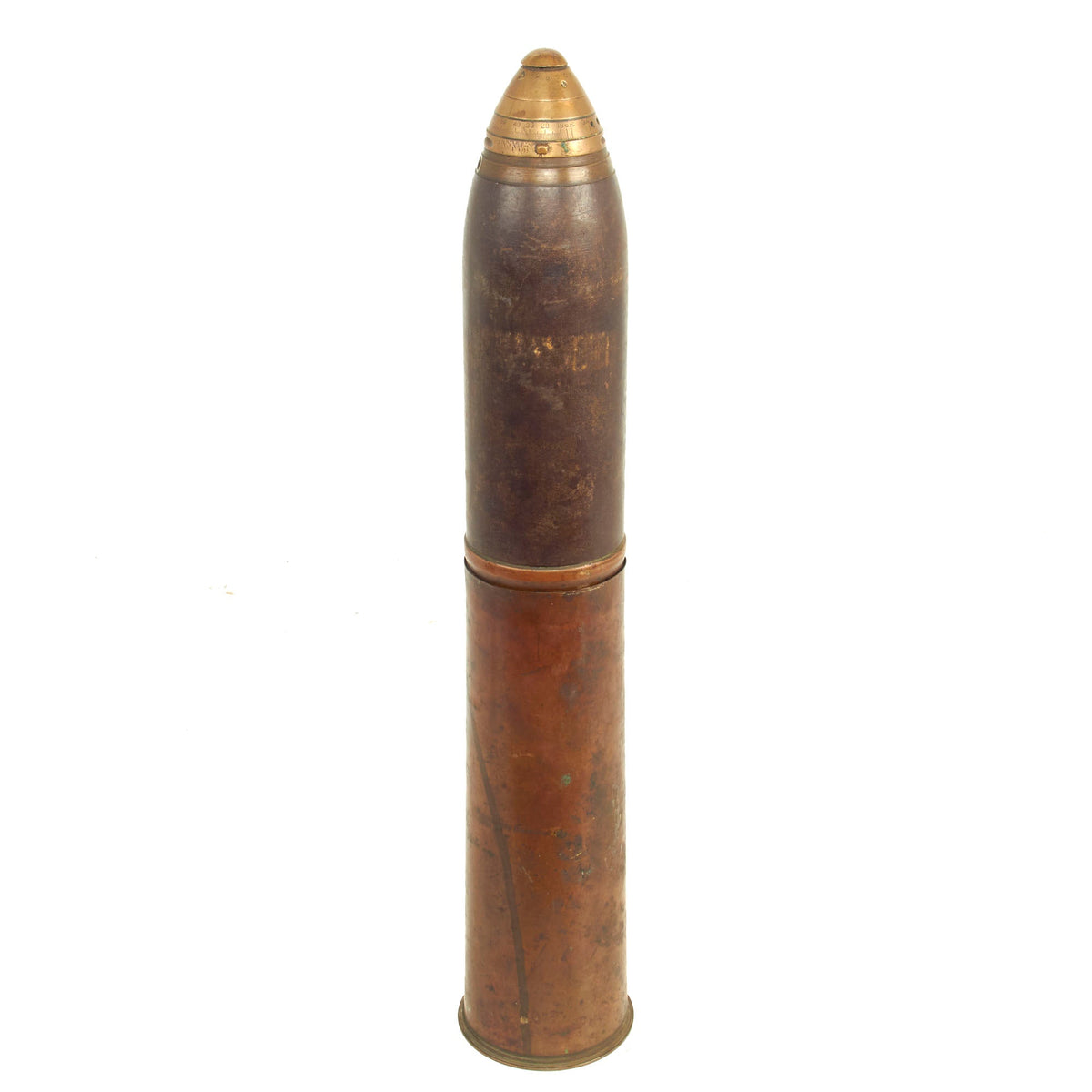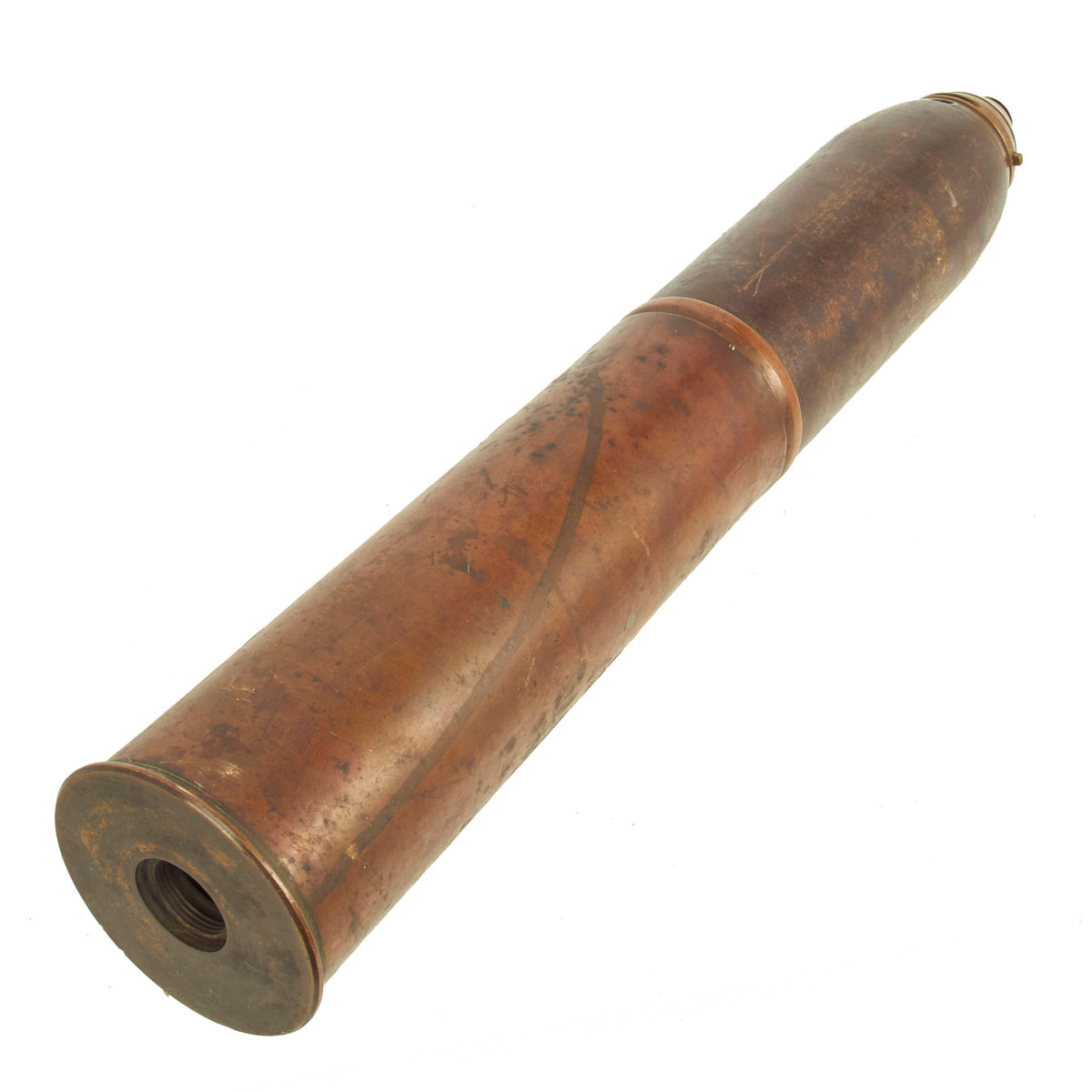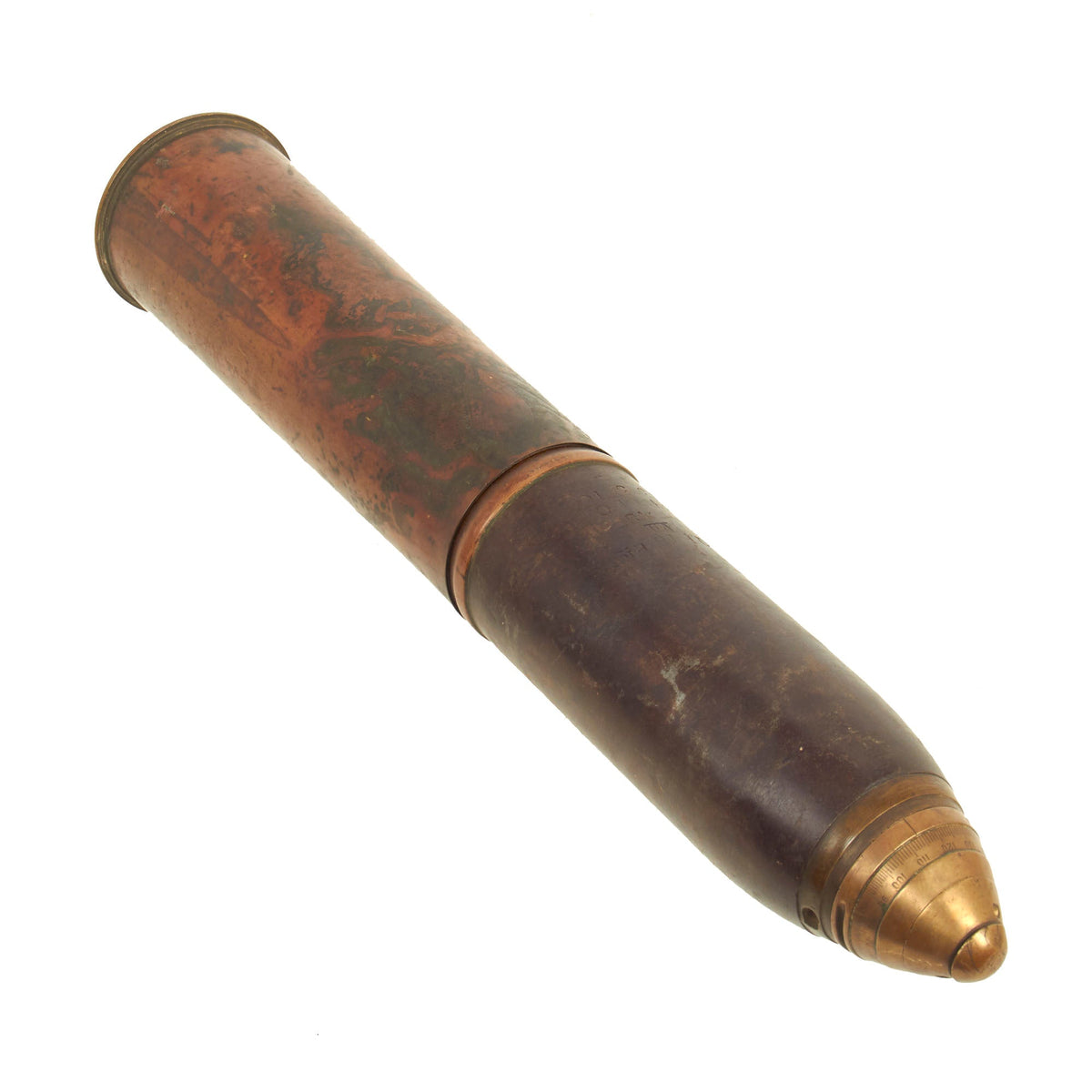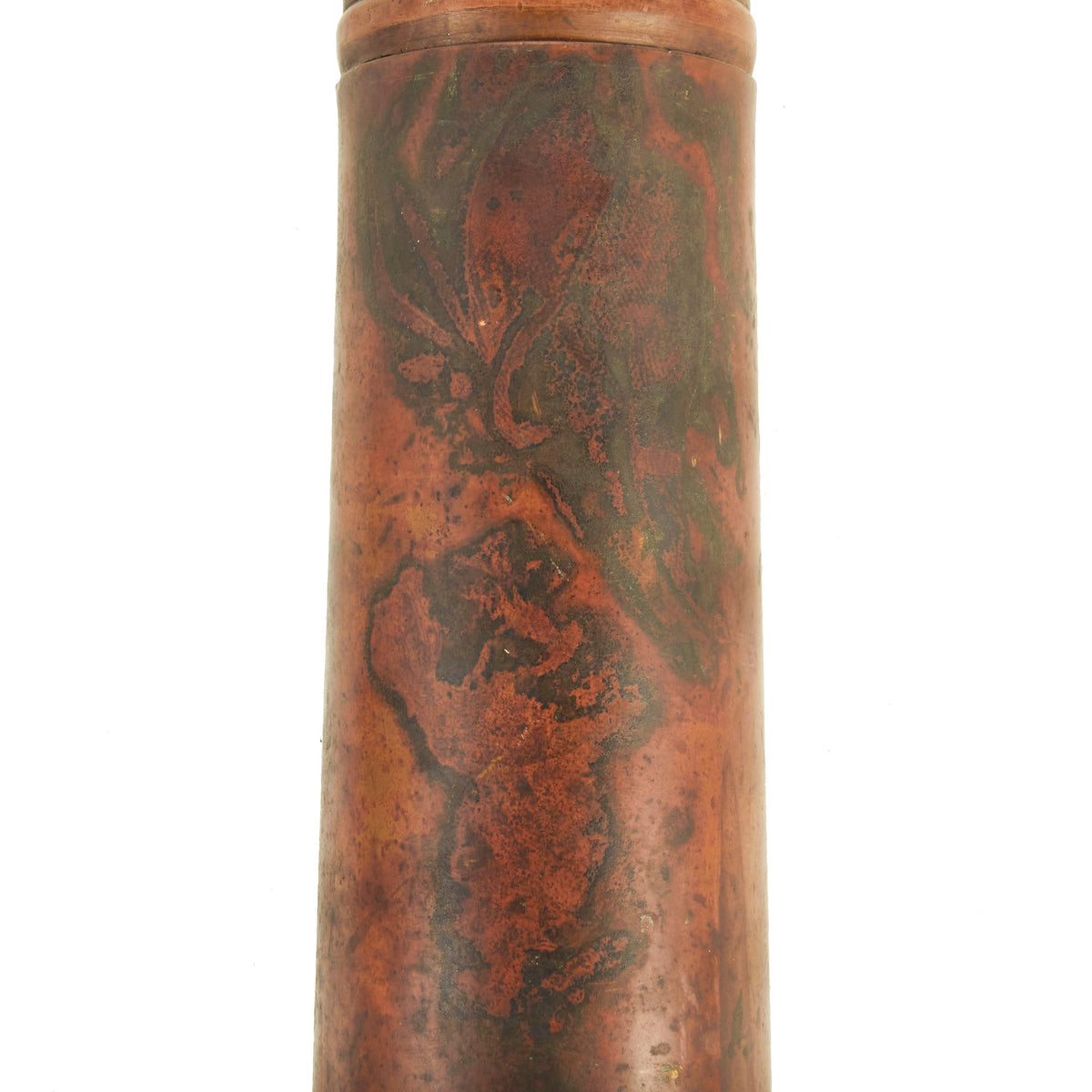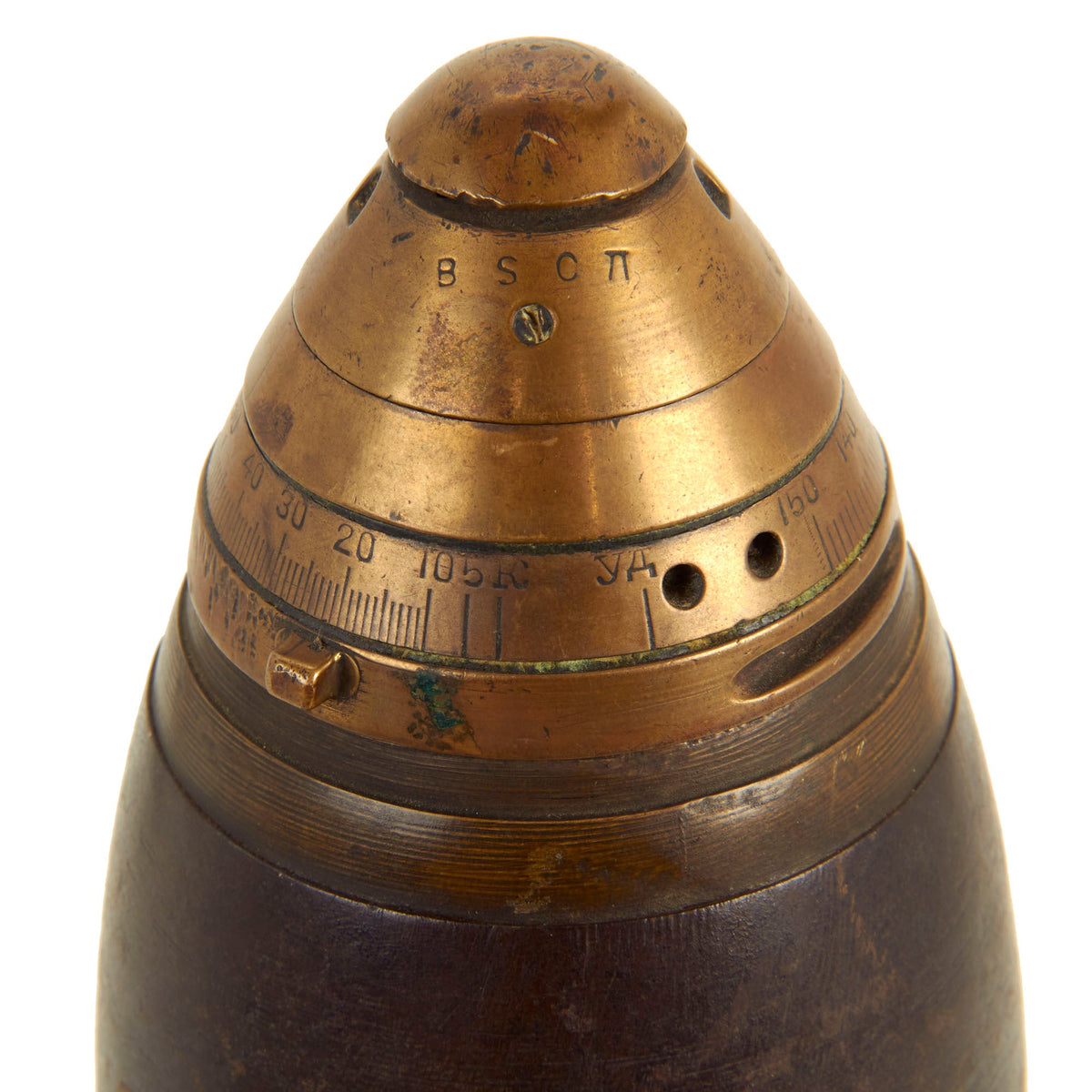Original British WWI Inert 84mm Artillery Shrapnel Round For The Ordnance Quick-Firing 18-pounder 7 cwt “18 Pounder” – Dated 1916 Original Items
$ 395,00 $ 118,50
Original Item: Only One Available. This is a fantastic example of a rather hard to find British artillery round from WWI. The round itself is for the “18 Pounder” field gun and is offered in “complete” condition without a primer but still has a few shrapnel balls inside of the projectile! The round is totally inert and void of any explosive content. It is in total compliance with the current BATF standards governing ordnance.
Not Available For Export
The Ordnance QF 18-pounder, or simply 18-pounder gun, was the standard British Empire field gun of the First World War-era. It formed the backbone of the Royal Field Artillery during the war, and was produced in large numbers. It was used by British Forces in all the main theaters, and by British troops in Russia in 1919. Its caliber (84 mm) and shell weight were greater than those of the equivalent field guns in French (75 mm) and German (77 mm) service. It was generally horse drawn until mechanization in the 1930s.
The first versions were introduced in 1904. Later versions remained in service with British forces until early 1942. During the interwar period, the 18-pounder was developed into the early versions of the equally famous Ordnance QF 25-pounder, which would form the basis of the British artillery forces during and after the Second World War in much the same fashion as the 18-pounder had during the First.
Measurements & Weight
Height: 22 ¼”
Base Width: 4”
Weight: 11.2 Pounds
18-pounder ammunition was a fixed round (i.e. the shell and brass cartridge case were loaded as a single unit, much like a large rifle cartridge), and fitted with a nose fuze. The normal service round was “Full Charge”, a “Reduced Charge” round was available for training. Double base propellant (nitroglycerine and nitrocellulose) was used, Cordite Mark 1 was the standard propellant when the gun was first introduced into service. By 1914, this cordite had been replaced by Cordite MD. During the First World War this was replaced by a revised formulation that was easier to produce called Cordite RDB.
Until September 1914, the only 18-pounder issued shell was shrapnel, fitted with a No. 80 “Time & Percussion” fuze (based on a Krupp design). The timer was set to open the shell and fire the bullets forward before it hit the ground. No 80 Fuze was an igniferous type of time fuze (as were most First World War time fuzes), meaning that it burnt gunpowder at a known rate to give a time from firing to fuze functioning. The shell did not burst, but projected spherical lead-antimony bullets forward in a cone, these bullets were effective up to 300 yards from the burst. 18-pounder carried 374 of the 41/pound size bullets. The fuze was designed to function as close as 50 yards from the muzzle if required, in order to eliminate the need for case shot. Observing shrapnel bursts was difficult and, after many experiments, gunpowder pellets were added to the tube between the fuze and the gunpowder ejecting charge in the base of the shell in order to emit a puff of smoke, this had the added advantage of widening the cone of the bullet spread.
A star shell with a time fuze (No 25) had been developed and small stocks were held before the war but it was not routine issue.
Pre-war experiments with 18-pounder HE shells had been inconclusive in terms of their benefits. However, the first month of the war showed that they were worth having and the first HE rounds arrived in September 1914. This was a different shape to the existing shrapnel shell so a new Mark 2 shrapnel shell was introduced to ensure ballistic compatibility. The original shrapnel shells had a relatively blunt ogive – 1.5 circular radius head (crh), the newer ones were 2 crh.
In 1914, the standard HE used by UK artillery was Lyddite, a formulation based on picric acid, this was a powerful explosive but expensive. TNT was introduced, but this too was expensive, particularly in its pure form required for shells so eventually Amatol was adopted. This was a mixture of ammonium nitrate and lower quality TNT, various proportions were used but eventually 80% ammonium nitrate and 20% TNT became standard. The parallel inside walls of the shell made it suitable for filling using preformed blocks of explosive as well as pouring.
Other types of shell were also introduced, although not as extensively as they were for howitzers and heavier guns. White phosphorus smoke shells became available in small quantities in 1916, and in 1918 chemical and incendiary shells were provided. The latter was a shrapnel type shell using thermite pellets, although a black powder incendiary shell for AA use against Zeppelins was introduced in 1916.
A lovely example ready for display.
Fast Shipping with Professional Packaging
Thanks to our longstanding association with UPS FedEx DHL, and other major international carriers, we are able to provide a range of shipping options. Our warehouse staff is expertly trained and will wrap your products according to our exact and precise specifications. Prior to shipping, your goods will be thoroughly examined and securely secured. We ship to thousands clients each day across multiple countries. This shows how we're dedicated to be the largest retailer on the internet. Warehouses and distribution centres can be located throughout Europe as well as the USA.
Note: Orders with more than one item will be assigned a processing date depending on the item.
Before shipping before shipping, we'll conduct a thorough inspection of the items you have ordered. Today, the majority of orders will be delivered within 48 hours. The delivery time will be between 3-7 days.
Returns
The stock is dynamic and we cannot completely manage it because multiple stakeholders are involved, including our factory and warehouse. So the actual stock may alter at any time. It's possible that you may not receive your order once the order has been made.
Our policy is valid for a period of 30 days. If you don't receive the product within 30 days, we are not able to issue a refund or an exchange.
You can only return an item if it is unused and in the same state as the day you received it. You must have the item in its original packaging.
Related products
Uncategorized
Uncategorized
Uncategorized
Australian WWII Owen MK1 Machine Carbine SMG Custom Fabricated Replica with Sling Original Items
Uncategorized
Uncategorized
Uncategorized
Uncategorized
Angolan Rebel 1970s era 60mm Inert Display Mortar from Angolan Civil War Original Items
Uncategorized
Uncategorized
Uncategorized
Uncategorized
Uncategorized
Uncategorized
Uncategorized
Band of Brothers ORIGINAL GERMAN WWII Le. F.H. 18 10.5cm ARTILLERY PIECE Original Items
Uncategorized
Uncategorized
Uncategorized
